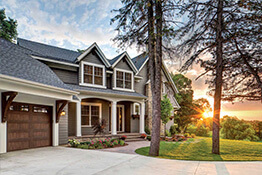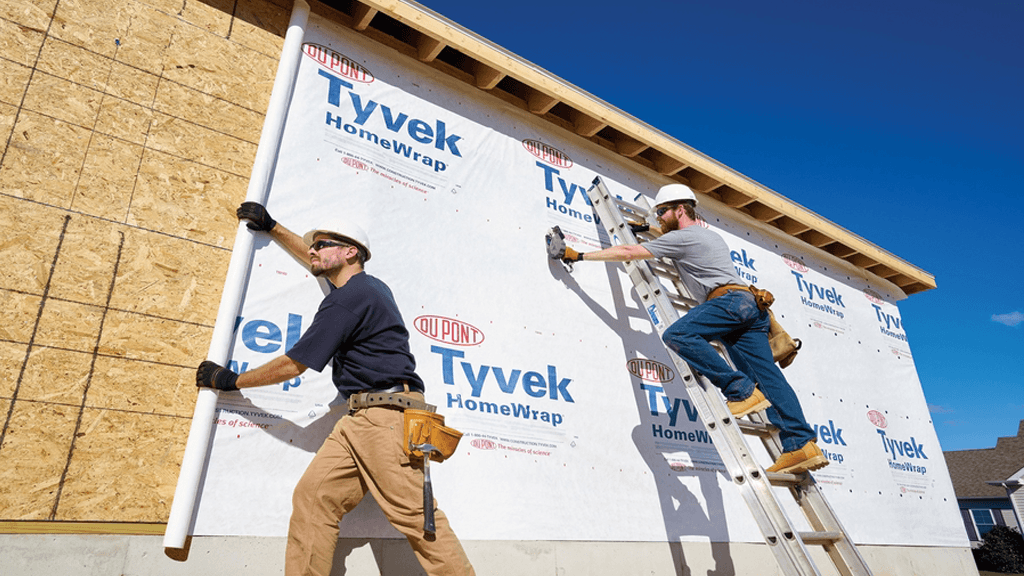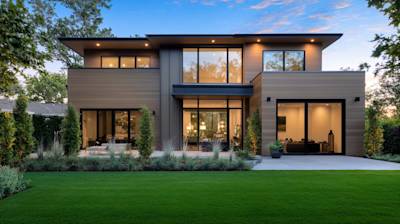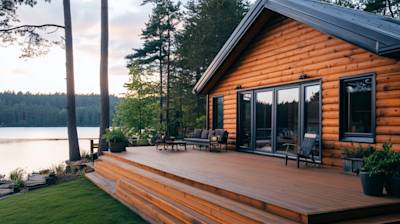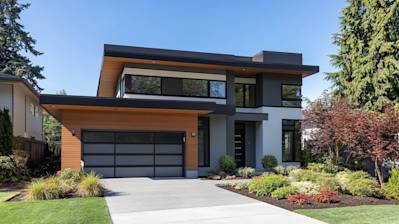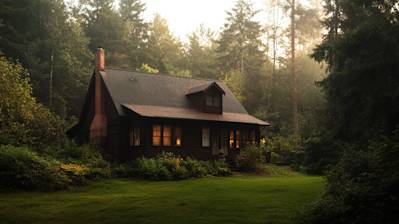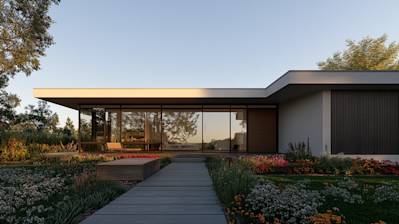A home is one of the most significant investments any individual can make. Preserving this investment and prolonging its lifespan are likewise crucial. We will focus on a building material that aids in these areas, namely Tyvek house wrap. This article aims to give a in-depth understanding of what Tyvek house wrap is, why your house needs one, its benefits, and how it is installed.
What is Tyvek House Wrap?
Tyvek house wrap is a durable, breathable weather-resistant material that improves buildings energy efficiency while protecting the interior structures from mold, mildew, and water damage. Manufactured by DuPont, Tyvek is made of spun bonded olefin, a synthetic material known for its high strength-to-weight ratio and resistance to moisture.
Purpose of Tyvek House Wrap
Although your home's exterior might look sturdy and indestructible, it also requires protection. This is where Tyvek house wrap comes in.
Moisture Resistance
One significant purpose of Tyvek house wrap is to resist exterior water intrusion while allowing water vapor (like humidity from cooking, showering, or even just breathing) to exit the building. This prevents your insulation from getting wet, thus providing the crucial functions of your home’s wall system to perform optimally.
Energy Efficiency
Another key value proposition is energy efficiency. By reducing the airflow through the walls, Tyvek house wrap helps to decrease energy costs in the long run.
How Tyvek House Wrap Works
Understanding how Tyvek house wrap functions might seem complex, but it boils down to two main mechanisms: breathability and durability.
Breathability
The innovative technology behind Tyvek house wrap allows it to be air and water-resistant yet breathable. It features tiny pores that prevent larger liquid water molecules from passing through while allowing smaller vapor molecules to escape.
Durability
Tyvek house wrap is well known for its durability. It provides excellent tear resistance and can withstand UV light for up to 120 days before being covered by siding. However, it is recommended to cover Tyvek as soon as possible to avoid damage from prolonged UV exposure.
Highlighted Benefits of Tyvek House Wrap
Tyvek house wrap comes packed with a multitude of benefits for homeowners and builders alike. Here are some noteworthy gains:
Mold and Mildew Prevention: By ensuring excellent water resistance and vapor permeability, Tyvek house wrap helps in preventing the growth of mold and mildew, thereby ensuring a healthier home environment.
Energy Conservation: By reducing uncontrolled air leakage, Tyvek helps to decrease energy costs related to heating or cooling.
Increased Comfort: With reduced drafts and cold spots, homes wrapped with Tyvek offer a more comfortable living environment.
Structural Protection: The wrap prevents water intrusion that may cause damage to the home's structure, ensuring longer building lifespan and durability.
Installation of the Tyvek House Wrap
While installing Tyvek house wrap may be done by an individual homeowner, hiring a professional can ensure the job is done correctly.
Preparation
To prepare the installation, begin by cleaning the sheathing of any dust or debris and ensure the surface is dry.
Installation
The Tyvek roll should be rolled out horizontally, and the wrap should be stapled to the plywood sheathe. Overlap the layers a minimum of 6 inches to provide a continuous barrier.
Finishing
After wrapping, all seams and edges need to be taped to further enhance air and moisture barrier properties. All openings such as doors and windows should also be properly flashed to prevent any water infiltration.
Frequently Asked Questions about Tyvek House Wrap
When should Tyvek house wrap be installed during construction?
Typically, Tyvek house wrap is installed after the sheathing but before any exterior siding or cladding is attached. It acts as a weather-resistant barrier, protecting the building structure during all stages of construction.
Can Tyvek house wrap be left exposed?
Tyvek house wrap is designed to be covered and should not be left permanently exposed to UV light. If left exposed for over 120 days, it may start to lose some of its water-resistant and permeability properties.
How to install Tyvek house wrap?
Begin by unrolling the Tyvek house wrap across the length of the wall ensuring it reaches from sill plate to top plate. Secure it with staples or cap nails, starting in the middle and working out to avoid wrinkles. Overlap the seams at least 6 inches for optimal protection. Make cuts for windows and doors, then tape around them using approved tape for sealing.
Is Tyvek House Wrap recyclable?
Yes, Tyvek house wrap is recycled through a national program called Tyvek Recycle. It accepts the wraps, converts them into pellets, and uses the same for producing a variety of construction-related goods. However, you need to ensure the wrap is clean, dry, and free from nails, staples, and adhesive tapes before sending it for recycling.
Can paint be applied on Tyvek house wrap?
Tyvek house wrap isn't made to hold paint. Paint will not properly adhere to the wrap and could cause the paint to crack or peel off over time. Additionally, painting Tyvek house wrap could affect its breathability and water resistance properties.
Can you use Tyvek house wrap on a roof?
Tyvek house wrap is not designed for roofing applications. Roofing systems already have their own specific type of underlayment which is often made from a material similar to Tyvek but specifically designed to stand up to the harsh conditions a roof can face.
How does Tyvek house wrap compare to other type of house wraps?
Compared to other types of house wraps, Tyvek house wrap offers a balanced performance when it comes to air and moisture management. Also, Tyvek house wraps have a high tear resistance and are more durable which means they can stand up quite well to on-site conditions during the construction phase.
Do you need to seal joints on a Tyvek house wrap?
It's strongly recommended to seal all Tyvek house wrap seams to make sure it acts as an effective weather barrier. Use an approved tape for this purpose to maintain its breathability and durability.
Pros & Cons of Tyvek House Wrap
When it comes to protecting your home from the elements, the exterior envelope is an essential component. No matter how carefully you’ve built your home, if it’s not properly sealed and insulated, it can still become susceptible to various problems. That’s where Tyvek House Wrap comes in. Designed to provide superior coverage and protection, Tyvek can be a great solution for many homes. But is it the right option for you? It’s time to explore the pros and cons of Tyvek House Wrap.
Pros of Tyvek House Wrap
Superior Weather Protection
One of the biggest benefits of Tyvek House Wrap is its ability to keep the elements out. It is designed to repel water and wind, preventing them from seeping into the walls and causing damage. Combined with appropriate siding, it forms a comprehensive barrier that provides excellent weather protection.
Breathability
While Tyvek House Wrap is excellent at keeping water out, it doesn’t trap moisture in. It is designed to let dampness escape from the inside, preventing it from becoming trapped within the walls and causing problems such as mold, mildew, or wood rot. This breathability allows your home to manage moisture effectively, without compromising on protection.
Lightweight and Easy to Install
Tyvek House Wrap is made from a synthetic material that is both durable and lightweight. It comes in large rolls that are easy to handle and manoeuvre onto the job site. It can be quickly and easily installed, reducing labor costs and project timelines.
UV Resistant
The material is also UV resistant, which means it can withstand exposure to the sun for longer periods. This is particularly beneficial during construction where the wrap might be exposed to direct sunlight for weeks or months before the siding is installed.
Energy Efficiency
By providing a tight seal against air leaks, Tyvek House Wrap can improve the energy efficiency of your home. It helps keep warm air in during the winter and cool air in during the summer, potentially reducing your energy costs.
Cons of Tyvek House Wrap
Cost
Despite all its benefits, one of the main drawbacks of Tyvek House Wrap is its cost. It is typically more expensive than other house wrap options and traditionally used building paper products. The cost can add up, especially on larger jobs, which might put it out of reach for some budgets.
Limited Interactiveness
Unlike some of the newer, interactive house wraps Tyvek does not stick directly to the sheathing, so it needs to be fastened securely. It also doesn't seal around nails or fasteners that penetrate it. If not properly installed, water and air can be trapped leading to rot and leaks.
Damage During Installation
While Tyvek House Wrap is durable, it can be punctured or torn during installation. If it’s not handled carefully, the material can become damaged, which can compromise its performance.
May Not Be Suitable for All Climates
While Tyvek House Wrap performs well in many climates, it may not be the best choice for extremely hot or cold environments. In very cold climates, the house wrap can become brittle and crack, while in hot climates, it may degrade more quickly under intense UV exposure.
Requires Professional Installation
To ensure it’s installed correctly and performs effectively, Tyvek House Wrap should be installed by a professional. If it’s fitted incorrectly, it can lead to problems down the line. This requirement can add to the overall cost of the product.
When considering whether to use Tyvek House Wrap for your project, weigh the pros against the cons carefully. Every home is unique, so it's important to choose the solution that best meets your specific needs. Discuss your options with a reliable contractor before making a decision.
Summary
Tyvek house wrap is a great investment if you're looking for a reliable and durable protective layer for your home. It's designed to keep unwanted air and water out, whilst letting water vapor escape to prevent mold and mildew. When installed properly, it can withstand high winds, rain, and other extreme weather conditions. It's a worthwhile choice if you're seeking long-term performance and value for your money.
Another great thing about Tyvek house wrap is its ease of installation. It is lightweight and comes in large rolls, making it easy to handle and install over large surfaces. It also reduces construction time and helps significantly in achieving energy efficiency goals. Plus, let's not forget the peace of mind knowing you're giving your home the ultimate barrier against harsh environmental elements.
Lastly, the Tyvek house wrap extends the life of your building. It keeps external elements from compromising the structural integrity of your home. This way, you're not just saving on maintenance costs, but you're helping the environment by reducing the need for frequent repairs and rebuilds. Consider it as a wise decision to protect your property, add value to it, and make it a more comfortable place to live in.
About US Quality Construction of Columbus
At US Quality Construction of Columbus, we're not just builders, we're your neighbors right here in Columbus, OH. With years of experience under our tool belts, we've become proficient at delivering high-quality construction services that not only meet but also exceed our clients' expectations. Whether you're daydreaming about a home remodel or planning an office building project, we work tirelessly to transform your ideas into reality. We partner with you, listening and responding to your needs, ensuring a smooth, perfectly executed and stress-free project. That's the US Quality Construction way.
Tags: building materials, waterproofing, construction,
